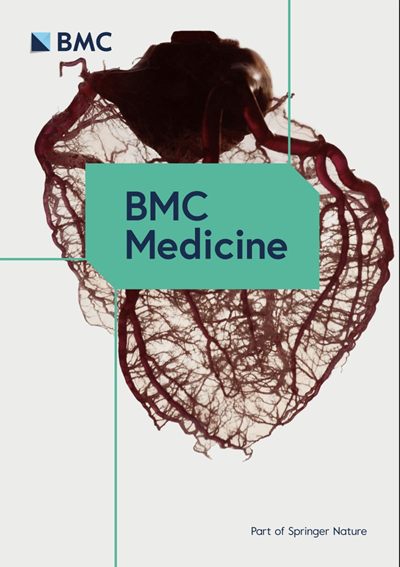以各种体育活动取代久坐行为与全因和特定原因死亡风险
IF 7
1区 医学
Q1 MEDICINE, GENERAL & INTERNAL
引用次数: 0
摘要
久坐行为(SB)已成为一个值得关注的重大健康问题。本研究旨在探讨长期久坐行为与全因和特定原因死亡风险之间的关系,并探索在体力活动(PA)方面替代久坐的理想方法。两项前瞻性队列研究分别使用英国生物库和美国国家健康调查(NHANES)数据集进行,参加者人数分别为 490,659 人和 33,534 人。我们采用 Cox 比例危险度回归模型来估算 SB 与癌症、心血管疾病(CVD)、呼吸系统疾病和消化系统疾病导致的全因和特定病因死亡风险之间的关系。此外,我们还采用了等时替代模型来研究用各种形式的活动来替代久坐的保护作用。在平均 13.5 年和 6.7 年的随访期间,英国生物库和 NHANES 分别记录了 36109 例和 3057 例死亡病例。这两个队列都表明,与每天坐姿少于 5 小时的人相比,坐姿时间较长的人因癌症、心血管疾病和呼吸系统疾病而导致全因死亡和特定原因死亡的风险较高,但消化系统疾病的风险不高。此外,用娱乐活动代替每天的久坐,甚至用 30 分钟的步行代替愉悦,可将全因死亡风险降低 3.5%(危险比 [HR]0.965,95% 置信区间 [CI] 0.954-0.977),而癌症、心血管疾病和呼吸系统疾病的特异性死亡率则分别降低了 1.6%(HR 0.984,95% CI 0.968-1.000)、4.4%(HR 0.956,95% CI 0.930-0.982)和 15.5%(HR 0.845,95% CI 0.795-0.899)。此外,随着运动强度的增加或替代持续时间延长至 1 小时,替代运动的保护作用会变得更加明显。久坐与癌症、心血管疾病和呼吸系统疾病的全因死亡率和特定病因死亡率风险大幅增加显著相关。然而,以各种形式的体育锻炼代替久坐,即使是短时间的相对轻微和放松的体育锻炼,也能有效降低全因死亡率和特定病因死亡率的风险。本文章由计算机程序翻译,如有差异,请以英文原文为准。
Replacement of sedentary behavior with various physical activities and the risk of all-cause and cause-specific mortality
Sedentary behavior (SB) has emerged as a significant health concern that deserves attention. This study aimed to examine the associations between prolonged sedentary behavior and the risk of all-cause and cause-specific mortality as well as to explore desirable alternatives to sitting in terms of physical activity (PA). Two prospective cohort investigations were conducted using the UK Biobank and NHANES datasets, with a total of 490,659 and 33,534 participants, respectively. Cox proportional hazards regression models were used to estimate the associations between SB and the risk of all-cause and cause-specific mortality due to cancer, cardiovascular disease (CVD), respiratory diseases, and digestive diseases. In addition, we employed isotemporal substitution models to examine the protective effect of replacing sitting with various forms of PA. During the average follow-up times of 13.5 and 6.7 years, 36,109 and 3057 deaths were documented in the UK Biobank and NHANES, respectively. Both cohorts demonstrated that, compared with individuals sitting less than 5 h per day, individuals with longer periods of sitting had higher risks of all-cause and cause-specific mortality due to cancer, CVD, and respiratory diseases but not digestive diseases. Moreover, replacing SB per day with PA, even substituting 30 min of walking for pleasure, reduced the risk of all-cause mortality by 3.5% (hazard ratio [HR] 0.965, 95% confidence interval [CI] 0.954–0.977), whereas cause-specific mortality from cancer, CVD, and respiratory diseases was reduced by 1.6% (HR 0.984, 95% CI 0.968–1.000), 4.4% (HR 0.956, 95% CI 0.930–0.982), and 15.5% (HR 0.845, 95% CI 0.795–0.899), respectively. Furthermore, the protective effects of substitution became more pronounced as the intensity of exercise increased or the alternative duration was extended to 1 h. SB was significantly correlated with substantially increased risks of all-cause mortality and cause-specific mortality from cancer, CVD, and respiratory diseases. However, substituting sitting with various forms of PA, even for short periods involving relatively light and relaxing physical activity, effectively reduced the risk of both overall and cause-specific mortality.
求助全文
通过发布文献求助,成功后即可免费获取论文全文。
去求助
来源期刊

BMC Medicine
医学-医学:内科
CiteScore
13.10
自引率
1.10%
发文量
435
审稿时长
4-8 weeks
期刊介绍:
BMC Medicine is an open access, transparent peer-reviewed general medical journal. It is the flagship journal of the BMC series and publishes outstanding and influential research in various areas including clinical practice, translational medicine, medical and health advances, public health, global health, policy, and general topics of interest to the biomedical and sociomedical professional communities. In addition to research articles, the journal also publishes stimulating debates, reviews, unique forum articles, and concise tutorials. All articles published in BMC Medicine are included in various databases such as Biological Abstracts, BIOSIS, CAS, Citebase, Current contents, DOAJ, Embase, MEDLINE, PubMed, Science Citation Index Expanded, OAIster, SCImago, Scopus, SOCOLAR, and Zetoc.
 求助内容:
求助内容: 应助结果提醒方式:
应助结果提醒方式:


